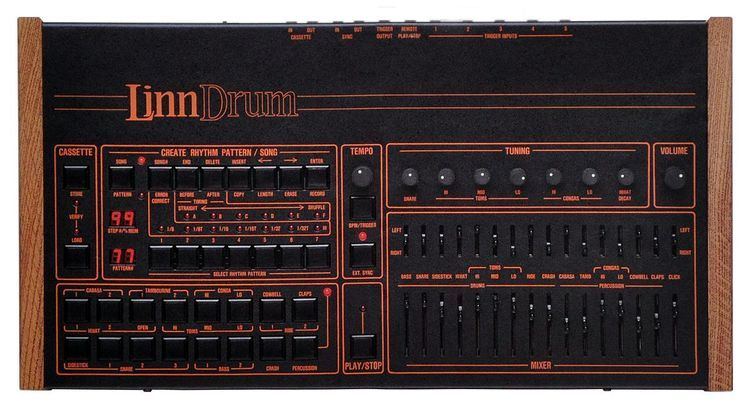Price US $2,995 Timbrality multitimbral 15 voices | Dates 1982–1985 Polyphony polyphonic 12 voices | |
 | ||
Synthesis type 8-bit digital samples, 28–35 kHz | ||
The LinnDrum (often erroneously referred to as the Linn LM-2) is a drum machine manufactured by Linn Electronics as the successor to the Linn LM-1. It was introduced in 1982 at a list price of $2,995. About 5,000 units were sold between 1982 and 1985. The Linn 9000 was the successor of the LinnDrum.
Contents
Its high-quality samples, flexibility and affordability made the LinnDrum popular; it sold far more units than its predecessor (the LM-1) and its successor (the Linn 9000) combined. Roger Linn re-used the moniker on the LinnDrum Midistudio and the Roger Linn Designs' LinnDrum II. The LinnDrum was used on many recordings throughout the 1980s, including international hits such as a-Ha's "Take on Me" and Tears for Fears' "Shout".
When Linn Electronics closed in 1986, Forat Electronics purchased its remaining assets and offered service, sounds and modifications for the LinnDrum. The LinnDrum was pre MIDI, but Retrofit Kits were offered by JL Cooper and Forat Electronics.
Features
The LinnDrum has fifteen 8 bit 28 kHz ~ 35 kHz digitally sampled drum sounds: bass drum, snare, side-stick snare, hi-hat, crash cymbal, ride cymbal, three tom-toms, cabasa, tambourine, high and low congas, cowbell, and hand-claps. Like the LM-1, it provided a sequencer for programming rhythm patterns, a built-in mixer and individual output jacks for each sound.
The LinnDrum improved on the LM-1 in many ways including: the addition of crash and ride cymbal samples, five external trigger inputs and the ability to replace built-in sounds with new sounds on EPROM chips. The LinnDrum sampled sounds from 28 to a 35 kHz sample rate. Also, the LinnDrum was $2,000 less than the LM-1.
One drawback: on the LinnDrum only the snare, tom and conga samples can be tuned, whereas the LM-1 allows every sound to be individually tuned.
LM-2
The LinnDrum is often erroneously called the LM-2, alluding to its predecessor, the Linn LM-1. LM-1 stood for Linn/Moffett/1. Alex Moffett, an early investor in the Linn drum computer development, wasn't with the company by the time the LinnDrum came around.
Drum Samples
According to some, the LinnDrum sounds were sampled from real drums played specifically for the machine by noted Los Angeles drummer Art Wood, good friend of Roger Linn, who also played with Linn as well as Peter Frampton, Gary Wright, Cher, Tina Turner, Bette Midler and James Brown, to name a few. However, "The LM-1 was the first drum machine to use samples of a real drum kit, Roger Linn confirms that it was indeed Art Wood session drummer that played the majority of the sounds that he used. To further add to the mystery, an entry in the online museum of the Roger Linn Design company credits L.A. session drummer Art Wood with most of the samples." While the Roger Linn Designs Past Products Museum page credits Art Wood for "most" of the LM-1 sounds, there is no credit for the drummer who played the sounds for the LinnDrum.
Influence
Although there have not been any official virtual instrument versions of the LinnDrum, several manufacturers have either emulated its interface and/or included samples of it. Such notable examples are as follows:
